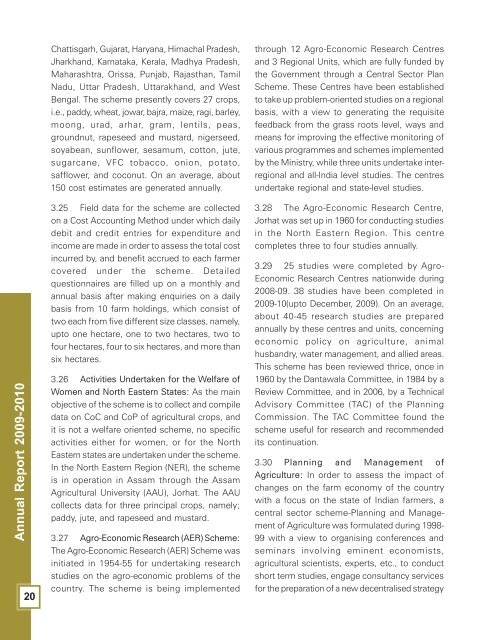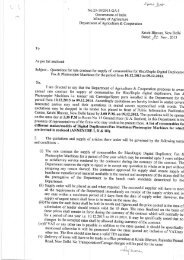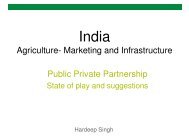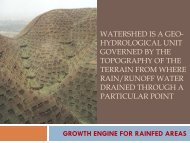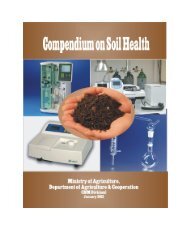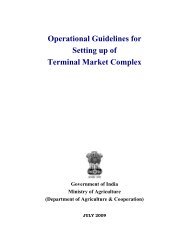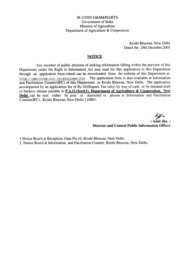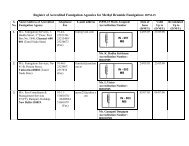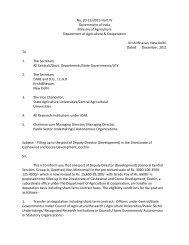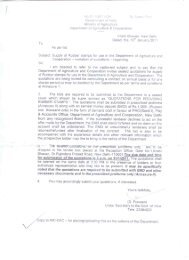Annual Report 2009-2010 - Department of Agriculture & Co-operation
Annual Report 2009-2010 - Department of Agriculture & Co-operation
Annual Report 2009-2010 - Department of Agriculture & Co-operation
You also want an ePaper? Increase the reach of your titles
YUMPU automatically turns print PDFs into web optimized ePapers that Google loves.
<strong>Annual</strong> <strong>Report</strong> <strong>2009</strong>-<strong>2010</strong><br />
20<br />
Chattisgarh, Gujarat, Haryana, Himachal Pradesh,<br />
Jharkhand, Karnataka, Kerala, Madhya Pradesh,<br />
Maharashtra, Orissa, Punjab, Rajasthan, Tamil<br />
Nadu, Uttar Pradesh, Uttarakhand, and West<br />
Bengal. The scheme presently covers 27 crops,<br />
i.e., paddy, wheat, jowar, bajra, maize, ragi, barley,<br />
moong, urad, arhar, gram, lentils, peas,<br />
groundnut, rapeseed and mustard, nigerseed,<br />
soyabean, sunflower, sesamum, cotton, jute,<br />
sugarcane, VFC tobacco, onion, potato,<br />
safflower, and coconut. On an average, about<br />
150 cost estimates are generated annually.<br />
3.25 Field data for the scheme are collected<br />
on a <strong>Co</strong>st Accounting Method under which daily<br />
debit and credit entries for expenditure and<br />
income are made in order to assess the total cost<br />
incurred by, and benefit accrued to each farmer<br />
covered under the scheme. Detailed<br />
questionnaires are filled up on a monthly and<br />
annual basis after making enquiries on a daily<br />
basis from 10 farm holdings, which consist <strong>of</strong><br />
two each from five different size classes, namely,<br />
upto one hectare, one to two hectares, two to<br />
four hectares, four to six hectares, and more than<br />
six hectares.<br />
3.26 Activities Undertaken for the Welfare <strong>of</strong><br />
Women and North Eastern States: As the main<br />
objective <strong>of</strong> the scheme is to collect and compile<br />
data on <strong>Co</strong>C and <strong>Co</strong>P <strong>of</strong> agricultural crops, and<br />
it is not a welfare oriented scheme, no specific<br />
activities either for women, or for the North<br />
Eastern states are undertaken under the scheme.<br />
In the North Eastern Region (NER), the scheme<br />
is in <strong>operation</strong> in Assam through the Assam<br />
Agricultural University (AAU), Jorhat. The AAU<br />
collects data for three principal crops, namely;<br />
paddy, jute, and rapeseed and mustard.<br />
3.27 Agro-Economic Research (AER) Scheme:<br />
The Agro-Economic Research (AER) Scheme was<br />
initiated in 1954-55 for undertaking research<br />
studies on the agro-economic problems <strong>of</strong> the<br />
country. The scheme is being implemented<br />
through 12 Agro-Economic Research Centres<br />
and 3 Regional Units, which are fully funded by<br />
the Government through a Central Sector Plan<br />
Scheme. These Centres have been established<br />
to take up problem-oriented studies on a regional<br />
basis, with a view to generating the requisite<br />
feedback from the grass roots level, ways and<br />
means for improving the effective monitoring <strong>of</strong><br />
various programmes and schemes implemented<br />
by the Ministry, while three units undertake interregional<br />
and all-India level studies. The centres<br />
undertake regional and state-level studies.<br />
3.28 The Agro-Economic Research Centre,<br />
Jorhat was set up in 1960 for conducting studies<br />
in the North Eastern Region. This centre<br />
completes three to four studies annually.<br />
3.29 25 studies were completed by Agro-<br />
Economic Research Centres nationwide during<br />
2008-09. 38 studies have been completed in<br />
<strong>2009</strong>-10(upto December, <strong>2009</strong>). On an average,<br />
about 40-45 research studies are prepared<br />
annually by these centres and units, concerning<br />
economic policy on agriculture, animal<br />
husbandry, water management, and allied areas.<br />
This scheme has been reviewed thrice, once in<br />
1960 by the Dantawala <strong>Co</strong>mmittee, in 1984 by a<br />
Review <strong>Co</strong>mmittee, and in 2006, by a Technical<br />
Advisory <strong>Co</strong>mmittee (TAC) <strong>of</strong> the Planning<br />
<strong>Co</strong>mmission. The TAC <strong>Co</strong>mmittee found the<br />
scheme useful for research and recommended<br />
its continuation.<br />
3.30 Planning and Management <strong>of</strong><br />
<strong>Agriculture</strong>: In order to assess the impact <strong>of</strong><br />
changes on the farm economy <strong>of</strong> the country<br />
with a focus on the state <strong>of</strong> Indian farmers, a<br />
central sector scheme-Planning and Management<br />
<strong>of</strong> <strong>Agriculture</strong> was formulated during 1998-<br />
99 with a view to organising conferences and<br />
seminars involving eminent economists,<br />
agricultural scientists, experts, etc., to conduct<br />
short term studies, engage consultancy services<br />
for the preparation <strong>of</strong> a new decentralised strategy


